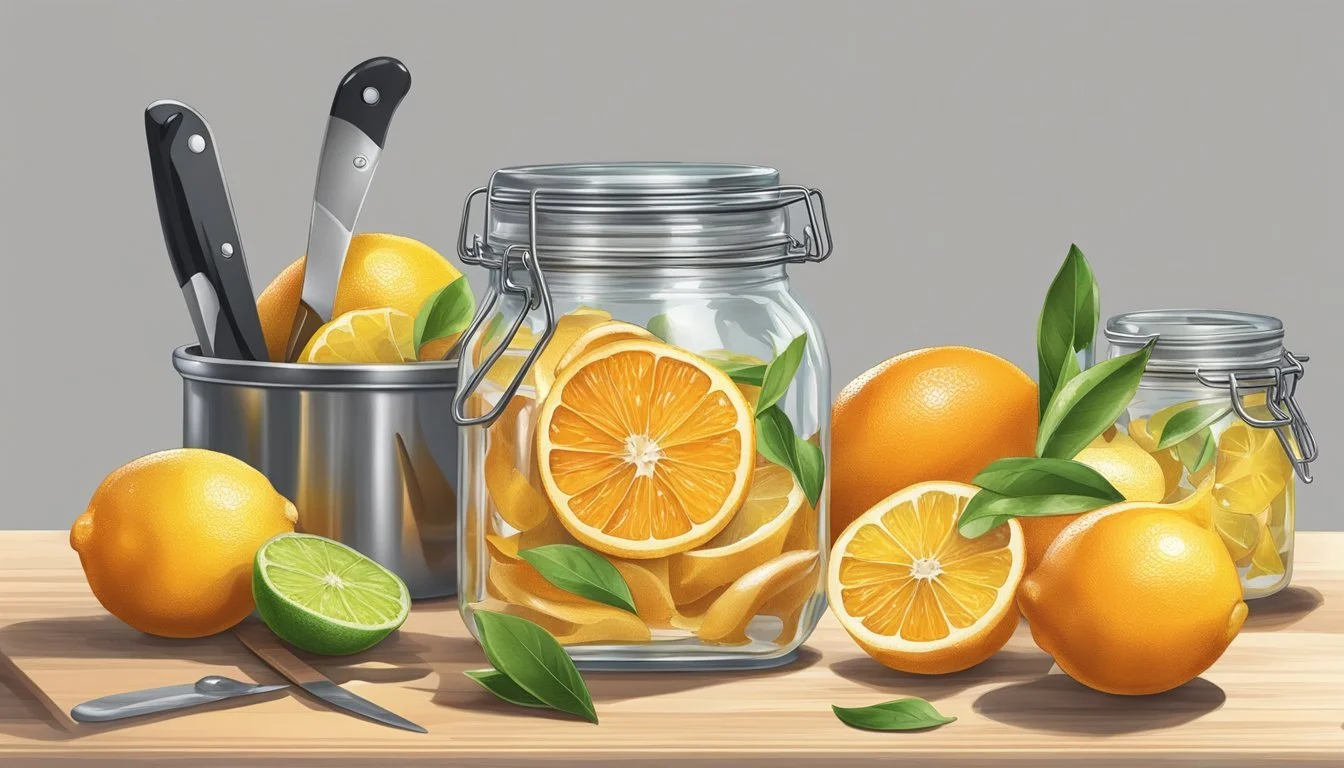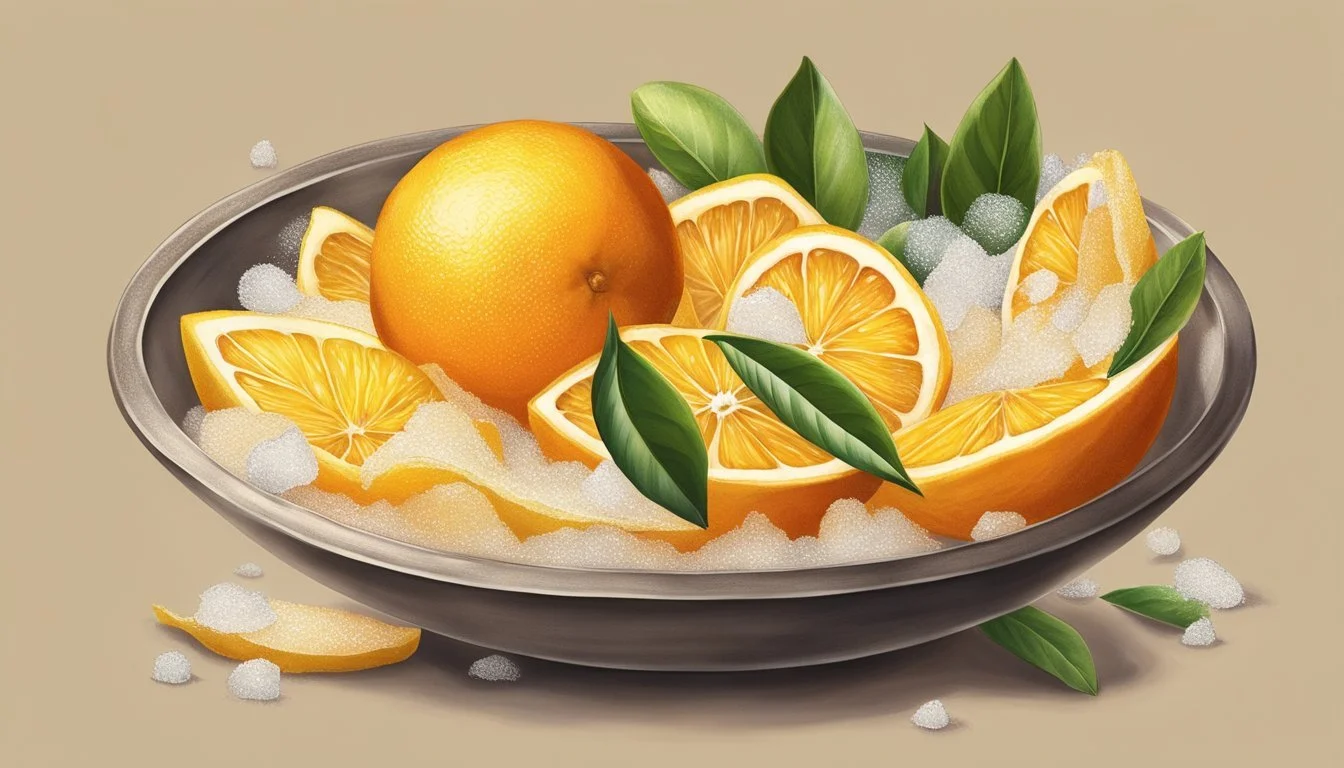Citrus Peel Oleo Saccharum
Unveiling the Secrets of Zesty Sweet Elixir
Citrus Peel Oleo Saccharum is a syrup that captures the essence of citrus zest in a concentrated, fragrant form. Steeped in tradition, this syrup is an age-old component favoured by culinary and cocktail enthusiasts alike for its ability to impart a robust citrus flavour without the tartness of juice. The process of making Oleo Saccharum involves infusing sugar with the oils from citrus peels, typically lemons, oranges, or grapefruits (What wine goes well with fruits?), coaxing out the natural oils to create a syrup that is rich in aroma and taste.
Making Oleo Saccharum is a simple yet delicate craft. It begins with carefully peeling the citrus to avoid the bitter pith, then the peels are combined with sugar. The mixture is then left to sit, allowing the sugar to draw out the flavorful oils from the peels. Over time, the sugar dissolves into these extracted oils, resulting in a Citrusy Syrup brimming with fragrance. This syrup is not only an ingredient in various mixed drinks, adding depth and complexity to cocktails, but it also finds its place in culinary recipes, enhancing desserts, dressings, and sauces.
The versatility of Citrus Peel Oleo Saccharum is remarkable, offering an infusion of citrus essence without the acidity or liquid content of fresh juice. It has become a staple in artisanal kitchens and bars, celebrated for its ability to elevate flavor profiles and transform simple recipes into gourmet delights. The syrup's concentrated nature means that a small amount goes a long way in intensifying the sensory experience of any creation it graces.
Fundamentals of Oleo Saccharum
Oleo saccharum, an essential element in classic cocktail making, harnesses the vibrant flavors and aromas from citrus peels through a process of sugar extraction.
Historical Background
Oleo saccharum, Latin for "oil sugar," is a traditional ingredient with roots going back to the early practices of European apothecaries. They discovered that sugar could draw out the essential oils from citrus peel, creating a potent syrup that captured the essence of the fruit's flavor and aroma. Bartenders later adopted this ingredient, recognizing its ability to enhance the complexity and depth of cocktails.
Basic Concepts
The basic principle underlying oleo saccharum involves the marriage of sugar and citrus peels. The process is simple yet effective:
Peeling: One obtains the peels of citrus fruits—commonly lemons, oranges, or grapefruits—taking care to minimize the presence of the bitter white pith.
Mixing: The peels are then muddled or combined with sugar to begin the extraction process.
Resting: Over time, the sugar draws out the essential oils from the peels, resulting in a fragrant, oil-rich syrup.
Straining: Finally, the mixture is strained, separating the now flavorful syrup from the spent peels.
This method efficiently captures the potent aroma and flavor of citrus fruits, making oleo saccharum a valuable component in various culinary applications, particularly in enhancing cocktails.
Ingredients and Tools
Creating a citrus peel oleo saccharum requires specific ingredients and tools to ensure a high-quality and flavorful syrup. This section delves into the optimal citrus fruits for oleo saccharum and the essential tools needed for the preparation process.
Choosing the Right Citrus Fruits
For oleo saccharum, the selection of citrus fruits largely influences the final aroma and taste. It is preferable to use organic fruits since they are less likely to have pesticides or waxes on their skins, which could affect the syrup. The typical fruits used are:
Lemons: A classic choice, providing a bright and tangy flavor.
Oranges: Sweet and less acidic, adding a milder citrus note.
Limes: Offer a sharp, vibrant twist, often more intense than lemons.
Grapefruit: Contributes a slightly bitter and robust profile.
The peels are the main ingredient. It is important that one chooses fruits with thick skins for more citrus oils and avoids the pith, as it can introduce bitterness.
Important Tools for Preparation
The crafting of oleo saccharum requires minimal but specific tools for efficiency and to avoid wastage of the citrus oils. The essential tools are:
Vegetable Peeler or Sharp Knife: To carefully remove peels while avoiding the bitter white pith.
Mixing Bowl: A medium-sized bowl to toss the citrus peels with sugar.
Storage Container: For the finished syrup, preferably glass to preserve the flavors.
Muddler (Optional): If one wishes to extract more oils by gently muddling the sugar-coated peels.
The combination of adequate sugar, typically caster sugar for its fine texture, and citrus peels in the right proportions is important to facilitate the extraction of the oils from the peels. One must ensure that the sugar thoroughly coats the peels to begin the extraction process, and then the mixture must sit, allowing time for the oils to infuse into the sugar.
Creating Your Oleo Saccharum
Creating oleo saccharum involves two main steps: preparation of citrus peels and extraction of their aromatic oils. Careful handling of the ingredients ensures a high-quality syrup suffused with citrus essence.
Preparation Techniques
One begins by selecting lemons or other citrus fruits, ensuring they are well-washed. The peels are then carefully removed with a vegetable peeler or sharp paring knife, taking care to leave the white pith behind, as it imparts a bitter flavor. Once peeled, the citrus peels are placed in a medium sized mixing bowl.
Ingredients:
Citrus peels (lemons, oranges, etc.)
Granulated sugar
Instructions:
Wash the citrus fruit thoroughly.
Carefully peel the fruit, avoiding the bitter white pith.
Place peels in a clean bowl.
Liberally toss the peels with sugar.
Extracting Oils from Citrus Peels
To extract the oils, one must coat the peels with sugar until they become sandy and begin to stick to the peels. A muddler can be used to gently press the peels and help release their essential oils, offering a more robust flavor.
Procedure:
Add sugar to citrus peels in the bowl and stir.
For a richer extraction, use a muddler to gently press the peels.
Cover the mixture and allow it to sit at room temperature.
The sitting time is crucial; a minimum of a few hours is required, with many recommending at least 6 hours or overnight. For some, letting the mixture sit for 24 hours achieves the best result. After the requisite time, the now fragrant and oily syrup is strained, separating the liquid from the peels. It's then ready for use or to be stored in the refrigerator.
Recipes and Applications
Oleo saccharum, the fragrant syrup crafted from citrus peel and sugar, is critically acclaimed for its role in enhancing cocktails and culinary dishes. Its rich oils and sweet profile make it an indispensable ingredient for those seeking to elevate their gastronomic creations.
Classic Cocktail Recipes
Oleo Saccharum serves as a superior base for a myriad of classic cocktails. Here's how it's commonly integrated:
Old Fashioned: A spoonful of oleo saccharum mixed with bourbon, a dash of bitters, served on the rocks.
French 75: Combine gin, lemon juice, oleo saccharum, and top with champagne for a refreshing twist.
Martini: Infuse the oleo saccharum with vodka or gin to impart a subtle citrus note before stirring with vermouth.
Punch: For a group serving, blend oleo saccharum with choice spirits, fruit juices, and soda water for a punch that packs a flavorful punch.
Innovative Uses in Cooking
Beyond cocktails, oleo saccharum finds its way into innovative culinary applications:
Iced Tea & Lemonade: Stir it into iced tea or lemonade for a sweet citrus boost.
Soda Water: Enhance plain soda water with a drizzle to create your personalized citrus soda.
Vinaigrettes: Whisk it into vinaigrettes for a zesty and sweet salad dressing that will impress.
Baking: Glaze for cakes or sweet bread with oleo saccharum to introduce a complex, citrus-infused sweetness.
Oleo saccharum's versatility in the kitchen and bar makes it a staple for those who appreciate depth and aroma in their beverages and dishes.
Storing and Preservation
Proper storage techniques are essential for maintaining the quality and extending the shelf life of oleo saccharum. It is important to understand optimal storage methods to maximize longevity and preserve the fresh aromatic qualities of this citrus syrup.
Optimal Storage Methods
For oleo saccharum, refrigeration is the preferred method of storage. The syrup should be transferred to an airtight container, such as a glass jar with a tight-sealing lid, to prevent the absorption of odors from the refrigerator. Avoid leaving the oleo saccharum at room temperature for prolonged periods once it has been mixed, as this can lead to spoilage.
Longevity and Freshness
In the refrigerator, oleo saccharum can typically maintain its freshness for up to two weeks. For extended preservation, freezing the syrup is an effective method. One can freeze the oleo saccharum either in ice cube trays or small freezer-safe containers. When stored in the freezer, expect the oleo saccharum to remain usable for up to six months, although it is best used within one month to ensure peak flavor and aroma.
Advanced Tips and Variations
Creating oleo saccharum is an art that benefits from experimentation and the introduction of complex flavors. This section will explore how to elevate the basic oleo saccharum recipe by experimenting with various citrus fruits and enhancing its flavor profiles.
Experimenting with Different Citrus
Citrus Variety: The choice of citrus is pivotal. Traditional recipes often call for lemons or oranges, but one can explore beyond the usual with blood oranges or grapefruits. The former gives a deep, rich color and a slightly berry-like note, while the latter offers a punchier, more bitter edge.
Blood Oranges: For a vibrant hue and a floral aroma, incorporate blood orange peels.
Grapefruits: Use grapefruit peels for a tangy syrup with a robust character.
Incorporating clementines can impart a sweeter and less acidic profile, which is perfect for those preferring a milder syrup.
Enhanced Flavor Profiles
Sweeteners and Botanical Additions: To broaden the syrup's flavor, cooks can play with different sweeteners. While white sugar is standard, using a sweetener like brown sugar can impart a deeper, molasses-like undertone.
Bitters: Introducing aromatic bitters into the oleo saccharum can add another dimension of flavor. Depending on the bitters used, one can infuse herbal, spicy, or even floral notes into the syrup.
To accentuate: Add a few dashes of bitters after the sugar has drawn out the citrus oils.
To complement: Choose bitters that pair well with the selected citrus peels.
By using these advanced tips and variations, aficionados can craft an oleo saccharum that not only stands out in flavor but also showcases their mastery of this classic cocktail component.
Health and Nutrition Considerations
When considering the health and nutrition aspects of oleo saccharum, it's important to recognize that the syrup primarily consists of two components—citrus peels and sugar. Citrus peels are known for their high levels of vitamin C and flavonoids, which are compounds that have antioxidant properties. These natural elements can contribute to a person's overall diet in a positive way.
Vitamin C: Known for its immune-boosting properties, vitamin C is abundant in citrus peels.
Flavonoids: Citrus peels contain flavonoids that have been associated with various health benefits, including anti-inflammatory effects.
However, the addition of sugar to create oleo saccharum means that this syrup should be consumed in moderation. Excessive sugar intake is linked to various health issues, such as weight gain and dental cavities. Individuals should be mindful of their sugar intake and consider oleo saccharum as an occasional treat rather than a staple.
Nutrient Presence in Oleo Saccharum Considerations Vitamin C High in citrus peels Positive impact on immune system Flavonoids Found in peels Antioxidant properties, contribute to health Sugar High Consume in moderation to avoid health risks
If an individual is seeking a more natural or organic approach to their diet, they may opt for organic citrus fruits and organic sugar when making oleo saccharum. This ensures that the ingredients are free from synthetic pesticides and fertilizers, aligning with a more natural dietary preference. Nevertheless, regardless of the source of the ingredients, the syrup should still be enjoyed in moderation due to its high sugar content.
Historical Cocktail Classics
In the landscape of mixology, the application of citrus oleo saccharum prominently shapes the flavor profiles of many historical cocktail classics. Its usage dates back to when cocktails were a novel concept, adding a complex citrus essence to the spirits of the time.
Prohibition-Era Citrus Cocktails
During Prohibition, creativity in cocktail creation soared out of necessity. The limited availability of quality spirits led mixologists to seek out robust ingredients like oleo saccharum to mask the harsh flavors of bootlegged alcohol. Recipes like the Bees Knees, a gin-based cocktail, heavily relied on the sweet and acidic nature of oleo saccharum to balance the drink. The citrus peel's oil, extracted through the sugar maceration process, became a critical component in these concoctions, serving both as a flavor enhancer and an aromatic element.
Citrus oleo saccharum was not only a workaround for poor-quality spirits; it was the soul of many cocktails that are today revered as classics. Ingredients in a typical Prohibition-era citrus cocktail might include:
Gin or other spirits
Citrus oleo saccharum
Additional sweeteners or sour mix, as needed
Ice and garnishes such as citrus slices or cherries
Jerry Thomas's Legacy
Jerry Thomas, often referred to as "the father of American mixology," left an indelible mark on cocktail culture. His use of oleo saccharum in classic punch recipes underscored the importance of balancing sweetness with acidity. In his 1862 book, "How to Mix Drinks or The Bon Vivant's Companion," Thomas detailed punch preparations that incorporated oleo saccharum to draw out the flavorful oils from citrus rinds, emphasizing its role in his punches and other cocktail recipes.
Thomas's work exemplifies the era's ingenuity in using oleo saccharum for its depth of flavor, making it a staple cocktail ingredient. Though the spotlight often shines on his use of spirits like gin, it's the underlying layers of complexity offered by components like citrus oleo saccharum that truly defined Jerry Thomas’s legacy. His classic formulas set a high bar for cocktail craft, inspiring countless mixologists to prioritize both taste and olfactory appeal in their creations. The use of oleo saccharum in classics such as the Brandy Punch demonstrates its versatility and time-tested appeal in the cocktail world.
Technical Aspects and Measurements
Creating oleo saccharum is as much a science as it is an art. Precision in measurements and an understanding of the chemical interaction between citrus oil and sugar are crucial to crafting a quality product.
Precision and Ratios in Oleo Saccharum
The first step in the creation of oleo saccharum is the careful measurement of ingredients. The ratio of sugar to citrus peel is vital, as this determines the balance of sweetness and citrus flavor. A common starting point is the use of approximately one cup of sugar for every two cups of tightly packed citrus peels. The type of citrus and size of the peels can affect the surface area, which in turn influences the extraction of oils, therefore precision in preparing the peels is important.
Weight and Volume Measurements:
Citrus Peels: 2 cups (tightly packed)
Sugar: 1 cup
The sugar should thoroughly coat the citrus peels for maximum contact. The prep time typically varies from a few hours to overnight, allowing the sugar to draw out the citrus oil, creating the syrup.
Understanding the Chemical Process
The extraction of citrus oil from the peels is a result of a chemical reaction where the sugar acts as a solvent, pulling the oils out through osmosis. This process is gradual:
Initially, sugar coats the peels and appears dry.
Over time, the peel releases citrus oil, and the sugar mix becomes wetter and takes on an oily sheen.
Ensuring that the peels are free from the bitter white pith and using granulated sugar that can effectively draw out the oils are critical. The resulting liquid is the oleo saccharum, which can be measured by volume for use in various recipes. The typical yield might vary, but a general expectation is:
Yield: Approximately 1/2 to 3/4 cups of oleo saccharum syrup
The stored oleo saccharum should retain its fragrant citrus essence and sweet flavor, highlighting the importance of these technical aspects in creating a quality syrup.
Oleo Saccharum in Modern Mixology
The incorporation of oleo saccharum has transformed modern mixology, providing bartenders and enthusiasts with a potent ingredient that imbues cocktails with a deep, citrus essence.
Contemporary Cocktail Creations
Oleo saccharum is recognized for its ability to amplify the flavor profile of cocktails. Mixologists often leverage its intense citrus oils and sweetness to balance the bitterness or acidity in their concoctions, making it a keystone in many bars. The meticulous process of muddling citrus peels with sugar, then allowing the mixture to sit before integrating it into a cocktail, is a testament to the craft of cocktail making. Spirits often mixed with oleo saccharum include gin, vodka, and rum, but its versatility extends beyond these to include a broad spectrum of base liquors.
Popular Cocktails with Oleo Saccharum:
Punches: A traditional use, adding both vibrant taste and aroma.
Sours: Delivers a richer dimension to these classic cocktails.
Non-Alcoholic Alternatives
Oleo saccharum isn't exclusive to the alcoholic realm. In non-alcoholic drinks, this syrup provides a similar depth of flavor. For those who prefer not to indulge in spirits, it presents an avenue to enjoy complex and satisfying drink experiences. Craft mocktails gain an edge with the addition of oleo saccharum, offering a profile that rivals their alcoholic counterparts without compromising on taste.
Mocktail Suggestions with Oleo Saccharum:
Citrus Spritzers: Combine with soda for a refreshing twist.
Herbal Lemonades: Infuse oleo saccharum with herbs for a flavorful alternative.
Troubleshooting Common Issues
Creating Oleo Saccharum can sometimes lead to a few common problems. By focusing on technique and patience, these issues can be resolved to achieve a fragrant and citrusy syrup.
Avoiding Bitterness and Pith Mistakes
When preparing citrus peels for Oleo Saccharum, the presence of pith, the white fibrous layer between the peel and the fruit, is the primary culprit of unwanted bitterness. To avoid this:
Use a vegetable peeler or a sharp paring knife: This helps to remove just the outer layer of the peel, minimizing the chances of including pith.
Inspect peels after cutting: If any pith remains on the peels, gently scrape it off with a knife to ensure that only the zest is used for maceration.
Attention to detail when peeling will significantly reduce the risk of a bitter syrup.
Dealing with Inconsistent Textures
Sometimes, the interaction between the citrus peels and sugar might not produce the desired texture. If the syrup is too thick or the sugar isn’t dissolving properly:
Adjust maceration time: Allow the peels and sugar to sit together for at least 6 hours, or as needed, to ensure that they fully interact.
Stir occasionally: This encourages the sugar to draw out the oils more effectively.
Use a sieve to separate solids: After the maceration is complete, it's important to strain the syrup through a fine-mesh sieve to remove any undissolved sugar or solid pieces of peel.
The consistency of the Oleo Saccharum can be controlled by monitoring the sugar’s dissolution during the maceration process and straining the final product.
Sustainability Practices
In the bartending and culinary world, sustainability is a pressing concern, as food and drink waste contribute significantly to overall trash accumulation. With the use of Oleo Saccharum, a syrup made from citrus peels, establishments can adopt a more sustainable practice by transforming what would be trash into a valuable ingredient.
Reduction of Waste: Citrus peels, typically discarded after fruit is juiced, are repurposed to create Oleo Saccharum. This process significantly cuts down on organic waste.
Utilization of Whole Fruit: By using the peel in the Oleo Saccharum process, bars and restaurants can utilize the entirety of the citrus fruit, aligning with the no-waste ethos.
Recipe Ratio:
Citrus Peel Weight Sugar Weight 1 part 1 part
In practical terms, bartenders collect the peels and muddle them with an equal weight of sugar to draw out the essential oils. The resulting mixture rests for a period, allowing the sugar to fully absorb the fragrant oils before it is used to enhance cocktails and punches.
The practice is not only sustainable but also cost-effective. Bars and restaurants capitalizing on ingredients that would otherwise be discarded exemplify financially savvy and environmentally conscious operations. By implementing the making of Oleo Saccharum into their routine, businesses showcase a commitment to sustainability. Additionally, this ingredient has the bonus of elevating the complexity and flavor profile of the beverages it enhances, offering patrons a unique tasting experience.
Decorative and Aesthetic Use
Citrus peel oleo saccharum not only imparts a rich flavor to cocktails and beverages but also has a significant role in the decorative and aesthetic enhancement of culinary presentations. Its vibrant colors and citrus fragrance enrich the sensory experience of dining.
Visual Appeal:
The translucent, amber-hued syrup when drizzled over desserts or incorporated into drinks adds a touch of elegance.
Bright citrus peels left from the oleo saccharum process can serve as an attractive garnish, adorning plates and glass rims.
Aromatic Pleasure:
With its concentrated citrus aroma, oleo saccharum elevates the olfactory ambiance of any space.
A small dab used on decorative features like a table centerpiece can subtly release its fragrance, enhancing the environment.
Table Settings:
When entertaining, chefs can use oleo saccharum as a decorative element on dinner tables.
Lightly coating the edges of cocktail glasses not only adds a hint of sweetness upon sipping but also renders a chic look to drinks.
In conclusion, the aesthetic applications of citrus peel oleo saccharum are as multifaceted as their culinary uses. Chefs and mixologists alike can utilize the visually appealing peels and the fragrant syrup to impart a sophisticated touch to their creations.
Conclusion
The creation of Citrus Peel Oleo Saccharum is a testament to the power of simplicity and the art of extracting flavors. This syrup captures the very essence of citrus peels, providing a rich, aromatic component that elevates cocktails and various culinary creations. Citrus peel oleo saccharum is made by macerating citrus peels with sugar to release essential oils, resulting in a fragrant syrup.
The process is straightforward: citrus peels are coated with sugar; the mixture is then allowed to sit and the oils to infuse. The patience required for the oleo saccharum to reach its aromatic peak pays dividends in the culinary uses it serves.
Here is a quick recap of the benefits:
It uses citrus peels that might otherwise be discarded, promoting a zero-waste approach in the kitchen.
The syrup imparts a concentrated citrus flavor that is more complex than juice or zest alone.
The oleo saccharum has a versatility in use, from enhancing beverages to being a component in dressings and desserts.
Citrus peel oleo saccharum stores well under refrigeration, often up to a week, making it a convenient ingredient to have on hand. Its ability to add depth and complexity to flavors makes it a cherished tool among culinary enthusiasts and professional bartenders alike. It emphasizes the importance of creativity and resourcefulness in food and drink preparation, reminding users that wonderful things often come from humble beginnings.











